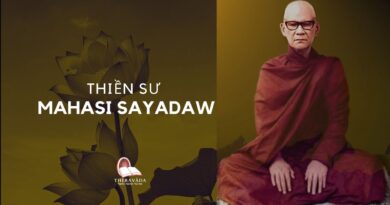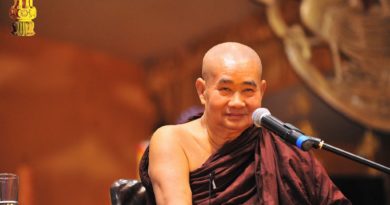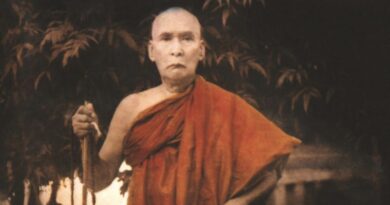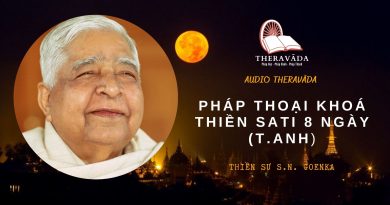Introduction To Vipassana Meditation – Venerable Ashin Silanandabhivamsa (agga Maha Pandita)
Venerable Ashin Silanandabhivamsa (Agga Maha Pandita)
(from the courtesy of nibbana.com)
Vipassana meditation is an awareness meditation. It teaches you to be with the present moment … to live in the present moment. It teaches to be aware of everything that comes to you and is happening to you. Only the present moment is important. And everything that comes to you at the present moment through the six sense doors eyes, ears, nose, tongue, body and mind — is to be noted, to be watched, to be observed as the object of awareness.
When you practise Vipassana meditation, by making mental notes or just watching the various things that come to you, you will bring awareness to a high level so that you will be able to see things as they truly are. You will come to see the true nature of mind and body, of the mental and physical phenomena of which you are composed. “True nature” means the nature of impermanence, the nature of unsatisfactoriness and the nature of insubstantiality or the absence of an unchanging self or soul. It is important to see these three characteristics of nature so that you can have a correct view of things so that you may have less attachment to mind and body, and gradually be able to weaken the hold of mental defilements that prevent enlightenment.
When you practice Vipassana meditation, you choose an object on which to focus your mind. That object will be the “home” object of meditation. Traditionally, the breath is taken as the object. You keep your mind focused on the breath and make mental notes “in-out, in-out” along with the breaths. During the noting of the breath when your mind gets lost or distracted, you make notes of them too, such as “thinking” or “hearing” or “distractions” or “emotions”, etc. And also you make notes of the feelings in your body. In this way, you keep yourself aware of everything that is happening in you or that comes to your mind.
By keeping your mind on the object of meditation, you are able to develop concentration or one-pointedness of mind which is necessary for the penetrative knowledge into the true nature of mind and body to arise. Without concentration, this cannot happen. So, what you need first is concentration. And in order to have concentration, you must first keep your mind focused on one object. If you can keep your mind focused on one and the same object for some time you can get the necessary concentration. But you will find that in the beginning this is very difficult to do even for a short time. That is because you are dealing with the mind, which is very unruly and difficult to control.
You can keep a wild bull by tying it with ropes. But you cannot tie your mind with ropes, so you tie your mind to the object with awareness or mindfulness. In the beginning, mindfulness may not be strong enough to tie the mind down to one object and you may have many distractions to interfere with your meditation. But when distractions come to you, whether through the eyes, ears or nose, etc., do not get irritated or upset. Just turn them into the objects of meditation by making notes of them too.
The beauty of Vipassana meditation lies in the fact that all things are the objects for this meditation, The breath is only the “home” object. If you have no other objects to note, just keep noting your breaths, and if there are other objects, you just keep noting them too. Whether you are keeping your mind on the breath or on other distractions, you are doing good meditation if you are aware of them.
When you practise Vipassana meditation, you have to be patient and persevere. And do not get discouraged if you cannot get concentration at the beginning. Everybody has that experience. And leave all your expectations behind when you are meditating. Just be in the present moment. And it these thoughts come to you in spite of the instructions, just make them the object of meditation. In this way, you can deal with everything that comes to you effectively.
|
Questions answer about Vipassana |
| Q 1. Where does the practice of Vipassana come from? |
|
Vipassana meditation comes from the tradition of Theravada Buddhism. There are two major divisions of Buddhism in the world today — Mahayana and Theravada. Mahayana tradition developed as Buddhism spread to the Northern Asian countries of Tibet, China, Japan, etc. Theravada tradition stayed in Southern Asia and spread to Sri Lanka, Burma, Thailand, Cambodia and Laos. |
| Q 2. What does Vipassana mean? |
|
The word Vipassana is composed of two parts “vi which means “in various ways and “passana” which means “seeing”. So Vipassana means seeing in various ways. |
| Q 3. What can Vipassana meditation do for me? |
|
The ultimate purpose of Vipassana is to eradicate mental impurities from your mind altogether. Before that stage, there are benefits of tranquility peace of mind and the ability to accept things as they come. Vipassana helps you to see things as they truly are, not as they appear to be. Things appear to be permanent, desirable and substantial, but actually they are not. When you practise Vipassana meditation, you will see for yourself the arising and disappearing of mental and physical phenomena. And you will have clearer comprehension of what is going on in your mind and body. You will be able to accept things as they come to you with less agitation and deal with situations in a more positive way. |
| Q 4. Who needs Vipassana Meditation? |
|
Vipassana meditation is for the cure of diseases of the mind in the form of mental defilements like greed, hatred, delusion, etc. We have these mental diseases with us almost all the time. In order to at least control them, we need ‘Vipassana meditation. |
| Q 5. When is Vipassana meditation needed? |
|
Since mental impurities are almost always with us, we need Vipassana meditation almost all of the time. There is no fixed time for the practice of Vipassana. Morning, during the day, before bedtime … anytime is the time of Vipassana. And Vipassana may be practised at any age. |
| Q 6. Do I have to be a Buddhist to practise Vipassana? |
|
There is nothing, which can be called particularly Buddhist in Vipassana meditation. There is no element of religion. It is a scientific investigation and examination of yourself. You must observe closely everything that comes to you and is happening to you in your body and mind at the present moment. |
| Q 7. Is Vipassana meditation difficult to practise? |
|
Yes and no. Meditation involves control of mind, and mind is most unruly. You come to know this personally when you practise meditation. So, it is not easy to practise Vipassana meditation because it is not easy to control the mind … to keep the mind on one and the same object. In another way, Vipassana meditation is easy to practise. There are no elaborate rituals to follow or much to learn before being able to practise Vipassana meditation. You just sit, watch yourself and focus your kind on the object… just that. |
| Q 8. Are there pre-requisites for Vipassana meditation? |
|
You need a genuine desire to practise and a readiness to follow the instructions closely because if you do not practise properly, you will not get the full benefits of meditation. You also need to have confidence in the practice and the teacher and an open mind to try it and see what it can do for you. Patience is also very important. When you meditate, you have to be patient with many things. There will be distractions; sensations in your body and you will be dealing with your mind. You must persevere when these distractions come and you cannot concentrate on the object. Also in Theravada Buddhism, purity of morals is emphasized because without pure moral conduct, there cannot be good concentration or peace of mind. Thoughts of something you have done will come to you again and again, especially when you are in meditation, and it will be more difficult for you to get good concentration. |
| Q 9. What gadgets do I need for Vipassana meditation? |
|
Actually, you don’t need anything at all. All you need is a place where you can sit down, close your eyes and focus on the object. But I am not against using cushions, benches or even chairs and other things because in order to practise meditation, you need some degree of comfort. But, while you don’t need to inflict pain on yourself unnecessarily, you should take care not to be too much attached to comfort or sloth and torpor will come to you and you will go to sleep. |
| Q 10. In what posture can Vipassana be practised? |
|
Vipassana meditation can and should be practised in all postures – sitting, standing, walking and lying down. Whatever you do, you should be mindful. |
| Q 11. Is cross – legged posture essential in sitting meditation? |
|
Although it is customary and traditional to sit on the floor to practise meditation, it is not essential in Vipassana. If you cannot sit cross-legged, you may sit in any way you like as long as it is comfortable for you. What matters in Vipassana is just the awareness, not the posture. |
| Q 12. Must my eyes be closed when meditating? |
|
It is better to keep your eyes closed, but you may leave them open if you like whichever is the least distracting for you. But if you happen to look at anything, then you have to be aware of the “looking” and note it. The important thing is to have good concentration. |
| Q 13. What should I do with my hands when meditating? |
|
There are no strict rules as to how to put your hand during Vipassana meditation. You may put them anyway you like. The most usual position is on the lap, one over the other. Or you may put your hands on your knees |
| Q 14. How long must I practise at a time? |
|
That depends on how much time you can spend for meditation. There is no fixed rule. It is good if you can sit for one hour. But if you cannot sit for one hour at the beginning, then you may sit half an hour or fifteen minutes and little by little extend the time, until you can sit longer. And if you can sit for more than an hour without much discomfort, you may sit two or three hours if you like. |
| Q 15. Should I practise every day? |
|
We eat every day, care for our bodies every day. Since we almost always have mental defilements with us, we need to cleanse our minds every day. I recommend the morning hours because then your body and mind are rested and you are away from the worries of the previous day. It would also do you good to meditate in the evening before you go to bed. But you may practise any time. Any if you make it a habit to practise every day, it will be good and beneficial to you. |
| Q 16. Do I need a teacher to practise Vipassana? |
|
This is important. Whenever you learn a new skill, you need a teacher. With the advice of a teacher, you learn quickly and you cannot go wrong. You need a teacher who is competent to give you instructions, correct your mistakes and give guidance when you have trouble in the course of meditation. There are some meditators who think they are making progress while in reality, they are not making any progress at all. And sometimes, they are making progress but think they are not doing well. Only the teacher can tell, and so at such a time he or she is indispensable. If you cannot find a teacher, you may rely on books, although no book can entirely take the place of a teacher. You may be able to do fairly well by reading the instructions and following them carefully. But even then, you may have need for discussion with a teacher occasionally. |
| Q 17. Can Vipassana be applied to daily life? |
|
You can have awareness of whatever you do whether you are working, walking, doing something, etc. It will not be as intense as in meditation or during a retreat, but a more general awareness. And when you apply mindfulness to problems in your life, you will be able to deal with yourself more effectively. |
| Q 18. What is meditation retreat? |
|
A meditation retreat provides an opportunity to deepen meditation practice in a supportive environment with the guidance of an experienced teacher. Everything you do at a retreat becomes the object of meditation. |
| Q19. What happens at a retreat? |
|
A retreat day consists of alternate periods of sitting and walking meditation, a nightly lecture and personal interview with the teacher. Continuity of practice is developed by bringing mindfulness to all other activities throughout the day as well. Noble Silence is observed during a retreat. Retreats can last for one day, a weekend, a week or longer. |
| Q 20. Why should I go to a meditation retreat? |
|
The intensive practice of a retreat is very beneficial for developing good concentration and quieting the mind. Since concentration is essential for penetrative wisdom to arise, a meditation retreat gives you the best possible opportunity to be able to experience for yourself the true nature of reality. |
| May all beings be well, happy and peaceful! |
|
Ven. Ashin Silanandabhivamsa, Agga Maha Pandita Theravada Buddhist Society of America 17450 S. Cabrillo Highway Half Moon Bay, CA 94019-2518, USA |
Source: http://www.yellowrobe.com/practice/meditation/225-introduction-to-vipassana-meditation.html

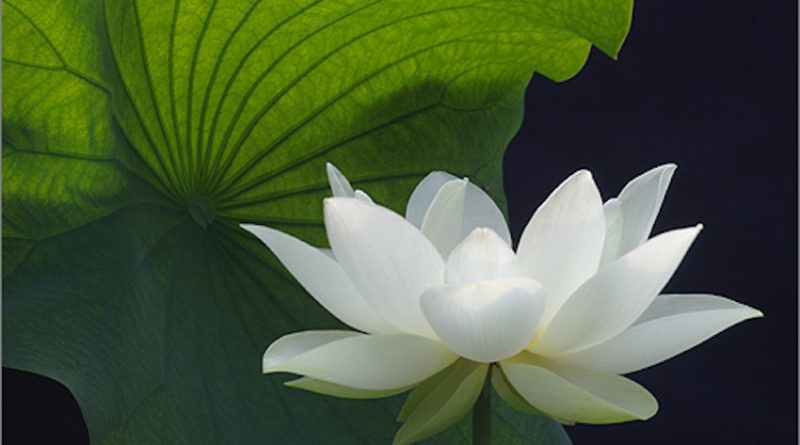
![Videos [khóa Thiền Vipassana 2017] 9. Cách Thức Hành Thiền Tiến Bộ, Kinh Nghiệm Của Ts | Thiền Sư U Jatila 2 9 8](https://satima.net/wp-content/uploads/2020/07/9-8-390x205.png)
